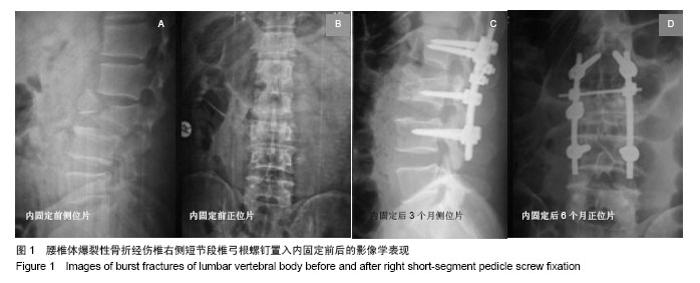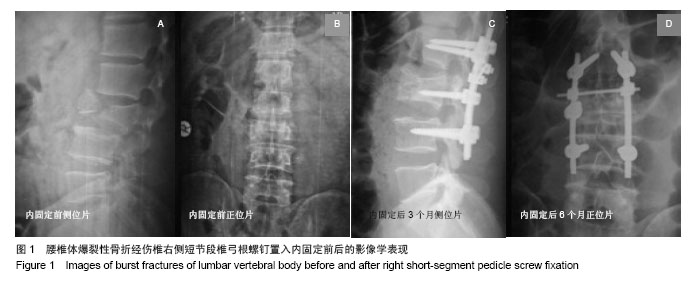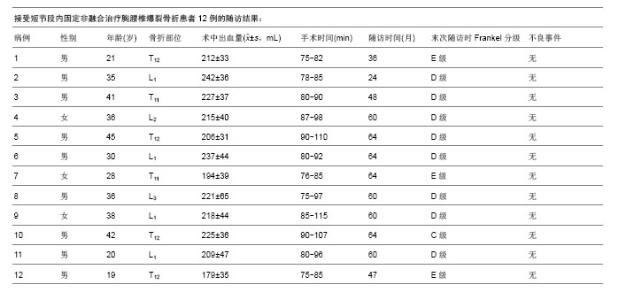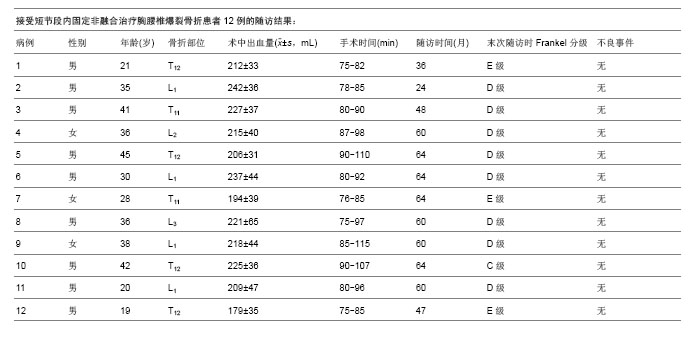Chinese Journal of Tissue Engineering Research ›› 2014, Vol. 18 ›› Issue (44): 7088-7093.doi: 10.3969/j.issn.2095-4344.2014.44.007
Previous Articles Next Articles
Short segment pedicle screw fixation without bone fusion for the repair of thoracolumbar burst fracture: mid-term follow-up
Ma Jing-xin1, Wang Xiang-yan2, Xu Guo-xing3
- 1Department of spine, 2Department of Orthopedics, Zhangqiu Chinese Medicine Hospital, Zhangqiu 102600, Shandong Province, China; 3Department of Orthopedics, Binnan Hospital, Shengli Petroleum Administration Bureau, Zhangqiu 250200, Shandong Province, China
-
Online:2014-10-22Published:2014-10-22 -
Contact:Xu Guo-xing, M.D., Associate chief physician, Department of Orthopedics, Binnan Hospital, Shengli Petroleum Administration Bureau, Zhangqiu 250200, Shandong Province, China -
About author:Ma Jing-xin, Attending physician, Department of spine, Zhangqiu Chinese Medicine Hospital, Zhangqiu 102600, Shandong Province, China
CLC Number:
Cite this article
Ma Jing-xin, Wang Xiang-yan, Xu Guo-xing. Short segment pedicle screw fixation without bone fusion for the repair of thoracolumbar burst fracture: mid-term follow-up[J]. Chinese Journal of Tissue Engineering Research, 2014, 18(44): 7088-7093.
share this article

2.1 参与者数量分析 按意向性处理,纳入12例胸腰椎爆裂骨折患者,全部进入结果分析,无脱落。 2.2 随访分析 本组病例的手术时间为75-118 min,平均95 min;术中失血量为200-335 mL,平均235 mL,所有病例术中均未输血。 本组患者均获至少5年的内固定后随访,所有病例均在内固定后12个月时取出胸腰椎内固定物。根据加州大学洛杉矶分校分级标准,在末次随访时,所有患者的损伤水平相邻节段均未发生退变情况。 2.3 椎管内占位率 经影像学测量发现,在椎管占位率评估方面(表1),内固定后多次测量结果较之初次内固定前,差异均有显著性意义(P < 0.05),内固定后多次的评估结果均显著优于内固定前,但内固定后多次评估结果之间差异无显著性意义(P > 0.05)。 2.4 伤椎高度 在伤椎椎体高度丢失率评估方面(表1),内固定后多次测量结果较之初次内固定前,差异均有显著性意义(P < 0.05),内固定后多次的评估结果均显著优于内固定前。 尽管在内固定取出后伤椎椎体高度出现丢失,但内固定取出后的多次评估结果与内固定后12个月内固定取出前相比,差异均无显著性意义(P > 0.05)。 2.5 Cobb角 在Cobb角评估方面(表1),内固定后多次测量结果较之初次内固定前,差异均有显著性意义(P < 0.05),内固定后多次的评估结果均显著优于内固定前。 尽管在内固定取出后Cobb角出现增大,但内固定取出后的多次评估结果与内固定后12个月内固定取出前相比,差异均无显著性意义(P > 0.05)。 2.6 临床疗效评估 本组病例内固定前的ASIA运动神经评分为34.2±6.3,末次随访时为47.7±9.5,差异有显著性意义(t=-4.103,P=0.000)。内固定取出后,所有病例均未出现神经功能损害症状加重。 根据Frankel分级标准,在末次随访时,内固定前3例B级患者中2例恢复至D级,1例恢复至C级;内固定前7例C级中6例恢复至D级,1例恢复至E级;内固定前2例D级患者均恢复至E级。 "

| [1]Dong SH, Chen HN, Tian JW,et al. Effects of minimally invasive percutaneous and trans-spatium intermuscular short-segment pedicle instrumentation on thoracolumbar mono-segmental vertebral fractures without neurological compromise. Orthop Traumatol Surg Res. 2013;99(4): 405-411. [2]Tofuku K, Koga H, Ijiri K,et al. Combined posterior and delayed staged mini-open anterior short-segment fusion for thoracolumbar burst fractures. J Spinal Disord Tech. 2012; 25(1): 38-46. [3]Jung HJ, Kim SW, Ju CI,et al. Bone cement-augmented short segment fixation with percutaneous screws for thoracolumbar burst fractures accompanied by severe osteoporosis. J Korean Neurosurg Soc. 2012;52(4): 353-358. [4]Alanay A, Acaroglu E, Yazici M,et al. The effect of transpedicular intracorporeal grafting in the treatment of thoracolumbar burst fractures on canal remodeling[J]. Eur Spine J. 2001;10(6): 512-516. [5]Radcliff K, Kepler CK, Rubin TA, et al. Does the load-sharing classification predict ligamentous injury, neurological injury, and the need for surgery in patients with thoraeolumbar burst fractures? Clinical article. J Neurosurg Spine. 2012;16(6):534- 538. [6]Yang H, Shi JH, Ebraheim M,et al. Outcome of thoracolumbar burst fractures treated with indirect reduction and fixation without fusion. Eur Spine J. 2011;20(3): 380-386. [7]张晓林,马信龙,陈长宝,等.后路短节段固定非融合方式治疗严重胸腰椎爆裂骨折[J].中华创伤杂志, 2013, 29(6): 493-497. [8]李朝辉.短节段非融合椎弓根螺钉固定治疗不稳定性胸腰椎爆裂骨折疗效观察[J].新乡医学院学报,2014,3(30):226-229. [9]连保卫,黎建文,朱爱剑,等.微创经皮椎弓根钉固定非融合技术治疗胸腰椎压缩性骨折35例临床观察[J].医学临床研究,2014, 31(2): 369-371. [10]Blondel B, Fuentes S, Metellus P, et al. Severe thoracolumbar osteoporotic burst fractures: treatment combining open kyphoplasty and short-segment fixation. Orthop Traumatol Surg Res. 2009;95(5):359-364. [11]Ge CM, Wang YR, Jiang SD, et al. Thoracolumbar burst fractures with a neurological deficit treated with posterior decompression and interlaminar fusion. Eur Spine J. 2011; 20(12):2195-2201. [12]柳超,刘建,王雷,等.椎弓根螺钉短节段固定联合椎体成形术治疗单节段胸腰段骨质疏松性椎体爆裂骨折[J].中国脊柱脊髓杂志, 2013,23(4):347-351. [13]李家谋,张昆亚,韩伟峰,等.短节段椎弓根螺钉置入内固定椎体成形治疗胸腰椎骨折的生物力学检测[J].中国组织工程研究与临床康复,2011,15(39):7284-7287. [14]Rodrigues CP, Ribeiro SM, Neves N, et al. Pedicle subtraction osteotomy in the treatment of post traumatic kyphosis following an osteoporotic fracture of the thoracolumbar spine. Acta Reumatol Port. 2011;36(2):184-186. [15]Uchida K,Nakajima H,Yayama T,et al. Vertebroplasty- augmented short-segment posterior fixation of osteoporotic vertebral collapse with neurological deficit in the thoracolumbar spine:comparisons with posterior surgery without vertebroplasty and anterior surgery.J Neurosurg Spine.2010;13(5):612-621. [16]Kim HY, Kim HS, Kim SW,et al. Short Segment Screw Fixation without Fusion for Unstable Thoracolumbar and Lumbar Burst Fracture : A Prospective Study on Selective Consecutive Patients. J Korean Neurosurg Soc. 2012;51(4): 203-207. [17]Lee GW, Jang SJ, Kim JD, et al. The efficacy of percutaneous long-segmental posterior fixation of unstable thoracolumbar fracture with partial neurologic deficit. Asian Spine J. 2013; 7(2):81-90. [18]Jiang SD, Wu QZ, Lan SH,et al. Reliability of the measurement of thoracolumbar burst fracture kyphosis with Cobb angle, Gardner angle, and sagittal index. Arch Orthop Trauma Surg. 2012;132(2): 221-225. [19]Toyone T, Ozawa T, Inada K,et al. Short-segment fixation without fusion for thoracolumbar burst fractures with neurological deficit can preserve thoracolumbar motion without resulting in post-traumatic disc degeneration: a 10-year follow-up study. Spine (Phila Pa 1976). 2013;38(17): 1482-1490. [20]Zheng GQ, Wang Y, Tang PF,et al. Early posterior spinal canal decompression and circumferential reconstruction of rotationally unstable thoracolumbar burst fractures with neurological deficit. Chin Med J (Engl). 2013;126(12): 2343-2347. [21]Yang JY, Lee JK, Song HS. The impact of adjacent segment degeneration on the clinical outcome after lumbar spinal fusion. Spine (Phila Pa 1976). 2008;33(5): 503-507. [22]曾至立,程黎明,高生,等.短节段椎弓根螺钉固定结合椎体增强术治疗胸腰椎爆裂性骨折[J].中华骨科杂志,2011,31(9):927-931. [23]刘煊文.短节段经皮椎弓根螺钉固定治疗58例胸腰段脊柱爆裂性骨折患者的临床效果[J].检验医学与临床,2014,11(5): 642-642. [24]Mueller LA, Mueller LP, Schmidt R,et al. The phenomenon and efficiency of ligamentotaxis after dorsal stabilization of thoracolumbar burst fractures. Arch Orthop Trauma Surg. 2006;126(6): 364-368. [25]Oner FC, van der Rijt RR, Ramos LM,et al. Changes in the disc space after fractures of the thoracolumbar spine. J Bone Joint Surg Br. 1998;80(5): 833-839. [26]Jindal N, Sankhala SS, Bachhal V. The role of fusion in the management of burst fractures of the thoracolumbar spine treated by short segment pedicle screw fixation: a prospective randomised trial. J Bone Joint Surg Br. 2012;94(8):1101-1106. [27]Aebli N, Timm K, Patrick M, et al. Short-segment posterior instrumentation combined with anterior spondylodesis using an autologous rib graft in thoracolumbar burst fractures. Acta Orthop. 2014;85(1):84-90. [28]潘俊,王根林,史金辉,等.间接复位治疗胸腰椎爆裂型骨折术后椎管重塑形[J].脊柱外科杂志, 2012, 10(2): 72-75. [29]Scapinelli R, Candiotto S. Spontaneous remodeling of the spinal canal after burst fractures of the low thoracic and lumbar region. J Spinal Disord. 1995;8(6): 486-493. [30]de Klerk LW, Fontijne WP, Stijnen T,et al. Spontaneous remodeling of the spinal canal after conservative management of thoracolumbar burst fractures. Spine (Phila Pa 1976).1998;23(9): 1057-1060. [31]Wang C, Yang MX, Weng W, et al. Successful short-segment fixation for thoracolumbar burst fractures using CYL-pedicle screw. Zhonghua Wai Ke Za Zhi. 2012;50(1):19-22. [32]Kim HS, Kim SW, Ju CI, et al. Implant removal after percutaneous short segment fixation for thoracolumbar burst fracture : does it preserve motion? J Korean Neurosurg Soc. 2014;55(2):73-77. |
| [1] | Song Chengjie, Chang Hengrui, Shi Mingxin, Meng Xianzhong. Research progress in biomechanical stability of lateral lumbar interbody fusion [J]. Chinese Journal of Tissue Engineering Research, 2021, 25(6): 923-928. |
| [2] | Yang Qin, Zhou Honghai, Chen Longhao, Zhong Zhong, Xu Yigao, Huang Zhaozhi. Research status and development trend of pelvic reconstruction techniques: a bibliometric and visual analysis [J]. Chinese Journal of Tissue Engineering Research, 2021, 25(23): 3718-3724. |
| [3] | Zhao Hongshun, A Jiancuo, Wang Deyuan, Xu Zhihua, Gao Shunhong. Factors affecting the height of early intervertebral space after lumbar interbody fusion via lateral approach [J]. Chinese Journal of Tissue Engineering Research, 2021, 25(21): 3332-3336. |
| [4] | Zhang Chongfeng, Li Xianlin, Peng Weibing, Jia Hongsheng, Cai Lei. Treating lumbar disc herniation of blood stasis type with Chinese herbs, acupuncture, moxibustion, and massage: a Bayesian network Meta-analysis [J]. Chinese Journal of Tissue Engineering Research, 2021, 25(17): 2781-2788. |
| [5] |
Zhang Cong, Zhao Yan, Du Xiaoyu, Du Xinrui, Pang Tingjuan, Fu Yining, Zhang Hao, Zhang Buzhou, Li Xiaohe, Wang Lidong.
Biomechanical analysis of the lumbar spine and pelvis in adolescent
idiopathic scoliosis with lumbar major curve |
| [6] | Fang Yi, Zhao Wenzhi, Pan Deyue, Han Xin, Zhang Lu, He Hongtao, Shi Feng, Tian Tingxiao. Acromioclavicular joint dislocation: how to achieve anatomical reduction, sustained stability and micro-motion [J]. Chinese Journal of Tissue Engineering Research, 2020, 24(5): 796-802. |
| [7] | Tuerhongjiang·Abuduresiti, Meng Xiangyu, Maihemuti·Yakufu, Wang Tiantang, Xieraili·Maimaiti, Dai Jifang, Wang Wei. Biomechanical advantages of percutaneous endoscopic lumbar discectomy for lumbar disc herniation [J]. Chinese Journal of Tissue Engineering Research, 2020, 24(36): 5768-5773. |
| [8] | Wang Jing, Xu Shuai, Liu Haiying. Hidden blood loss during posterior lumbar interbody fusion in lumbar spinal stenosis patients with and without rheumatoid arthritis [J]. Chinese Journal of Tissue Engineering Research, 2020, 24(33): 5307-5314. |
| [9] | Shen Canghai, Feng Yongjian, Song Yancheng, Liu Gang, Liu Zhiwei, Wang Ling, Dai Haiyang. Value of quantitative MRI T2WI parameters in predicting surgical outcome of thoracic ossification of the ligamentum flavum [J]. Chinese Journal of Tissue Engineering Research, 2020, 24(18): 2893-2899. |
| [10] | Pu Xingyu, Luo Wenyuan, Qian Yaowen, Cai Liyang, Zhang Chao, Chen Shaolong, Wang Yue, Zhang Wei . Unicompartmental knee arthroplasty for medial compartmental knee osteoarthritis in young and middle-aged patients: a short-term follow-up [J]. Chinese Journal of Tissue Engineering Research, 2019, 23(8): 1161-1166. |
| [11] | Fu Jiaxin, Xiao Lianping, Wang Shusen, Li Xiaodong, Han Liqiang, Wang Tonghao. Therapeutic effects of paraspinal approach combined with internal fixation through pedicle of fractured vertebra versus traditional AF screw-rod system for thoracolumbar fractures [J]. Chinese Journal of Tissue Engineering Research, 2019, 23(8): 1177-1181. |
| [12] | Qiu Zhongpeng, Li Ke, Li Gang, Liu Keyu, Du Xinhui, Meng Defeng, Shi Chenhui, Wang Weishan. Different treatments for two-part and three-part proximal humeral fractures by Neer classification: follow-up results analyzed using clinical economics [J]. Chinese Journal of Tissue Engineering Research, 2019, 23(8): 1188-1195. |
| [13] | Chen Xiaokang, Wu Zhengjie, Zhou Bingxue, Zhou Jiansheng, Hong Shi. Semi-restrictive total elbow arthroplasty for complex distal humeral fractures in the older adults: one-year follow-up [J]. Chinese Journal of Tissue Engineering Research, 2019, 23(8): 1168-1171. |
| [14] | Ke Wei, Li Ke, Wang Sibo, Du Xinhui, Qiu Zhongpeng, Kang Zhilin, Wang Weishan, Li Gang . Open reduction and plate fixation versus closed reduction and external fixation for distal radius fractures: scores and linear regression analysis [J]. Chinese Journal of Tissue Engineering Research, 2019, 23(8): 1196-1202. |
| [15] |
Wen Yi, Su Feng, Liu Su, Zong Zhiguo, Zhang Xin, Ma Pengpeng, Li Yuexuan, Li Rui, Zhang Zhimin.
Establishment of finite element model of L4-5 and mechanical analysis of degenerative intervertebral discs
|
| Viewed | ||||||
|
Full text |
|
|||||
|
Abstract |
|
|||||



